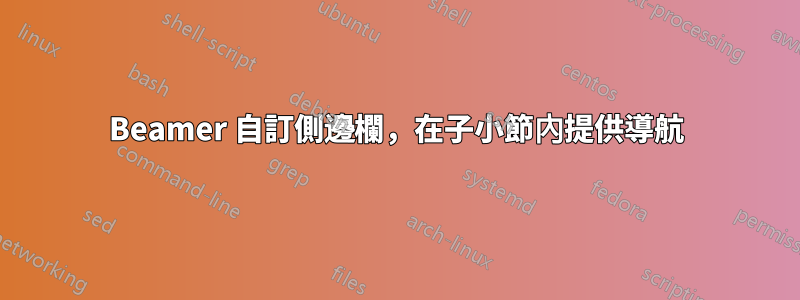
我想在我的投影機簡報中添加左手側邊欄,但是我想如何執行此操作有一些具體細節:
- 側邊欄僅出現在指定頁面上(大多數投影片沒有側邊欄)
- 側邊欄不會顯示演示文稿其餘部分的任何部分或小節的導航,而是包含指向一系列其他幻燈片的鏈接,這些幻燈片也都具有此側邊欄。
- 該側邊欄可以在簡報中多次調用,它將遵循相同的格式,但每次調用時它都會位於不同的位置,並引用該位置的幻燈片。
- 我根本不希望這影響頂部導覽欄
- 理想情況下,我會將側邊欄引用的所有內容放在自己的子小節中,但並非所有子小節都會有此側邊欄
了解它的用途可能會有所幫助;我想創建一個側邊欄,顯示如何解決數學問題的步驟,其中幻燈片主要部分的內容是特定問題的細節。
這是一些提供一些可以使用的程式碼:
\documentclass[14pt]{beamer}
\usetheme{Frankfurt}
\begin{document}
\section{Section 1}
\subsection{Section 1.1}
\begin{frame}
\frametitle{1.1.1}
\end{frame}
\begin{frame}
\frametitle{1.1.2}
\end{frame}
\subsection{Section 1.2}
\begin{frame}
\frametitle{1.2.1}
\end{frame}
\begin{frame}
\frametitle{1.2.2}
\end{frame}
\subsection{Section 1.3}
\begin{frame}
\frametitle{1.3.1}
\end{frame}
\begin{frame}
\frametitle{1.3.2}
\end{frame}
\section{Section 2}
\subsection{Section 2.1}
\subsubsection{Section 2.1.1}
\begin{frame}
\frametitle{2.1.1 part A}
This would be the start to the problem
\end{frame}
\begin{frame}
\frametitle{2.1.1 part B}
This would start the solution
\end{frame}
\begin{frame}
\frametitle{2.1.1 part C}
This would have the next step
\end{frame}
\begin{frame}
\frametitle{2.1.1 part D}
This next step process would continue here (and to further slides if needed)
\end{frame}
\subsection{Section 2.2}
\begin{frame}
\frametitle{2.2.1}
\end{frame}
\begin{frame}
\frametitle{2.2.2}
\end{frame}
\end{document}
在本文檔中,我希望側邊欄位於本文檔的小節部分。這將是一個定制的側邊欄,但首先我只想專注於將其實現到那裡。
理想情況下,該小節中的側邊欄應包含連結到該小節中各個投影片(但不一定是所有投影片)的文字。
答案1
你的問題對我來說聽起來太具體了,自動化的解決方案是值得的。那麼為什麼不手動添加您需要的菜單呢?您只需在要連結的框架上新增標籤。然後您可以從任何您想要的地方連結到它們 - 例如自訂側邊欄選單。
\documentclass{beamer}
\begin{document}
\section{Section 2}
\subsection{Section 2.1}
\subsubsection{Section 2.1.1}
\begin{frame}[label=problem]{2.1.1 part A}
\begin{minipage}{0.25\linewidth}
\footnotesize
\begin{enumerate}
\item \hyperlink{problem}{\textbf{Problem}}
\item \hyperlink{solution}{Solution}
\item \hyperlink{next}{Next Step}
\end{enumerate}
\end{minipage}%
\begin{minipage}{0.75\linewidth}
This would be the start to the problem
\end{minipage}
\end{frame}
\begin{frame}[label=solution]{2.1.1 part B}
\begin{minipage}{0.25\linewidth}
\footnotesize
\begin{enumerate}
\item \hyperlink{problem}{Problem}
\item \hyperlink{solution}{\textbf{Solution}}
\item \hyperlink{next}{Next Step}
\end{enumerate}
\end{minipage}%
\begin{minipage}{0.75\linewidth}
This would start the solution
\end{minipage}
\end{frame}
\begin{frame}[label=next]{2.1.1 part C}
\begin{minipage}{0.25\linewidth}
\footnotesize
\begin{enumerate}
\item \hyperlink{problem}{Problem}
\item \hyperlink{solution}{Solution}
\item \hyperlink{next}{\textbf{Next Step}}
\end{enumerate}
\end{minipage}%
\begin{minipage}{0.75\linewidth}
This would have the next step
\end{minipage}%
\end{frame}
\begin{frame}{2.1.1 part D}
This next step process would continue here (and to further slides if needed)
\end{frame}
\subsection{Section 2.2}
\begin{frame}{2.2.1}
\end{frame}
\begin{frame}{2.2.2}
\end{frame}
\end{document}


